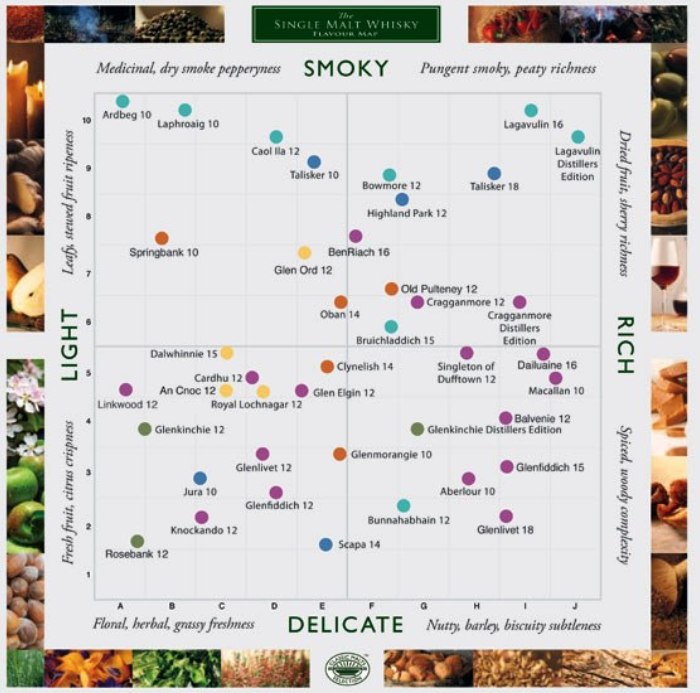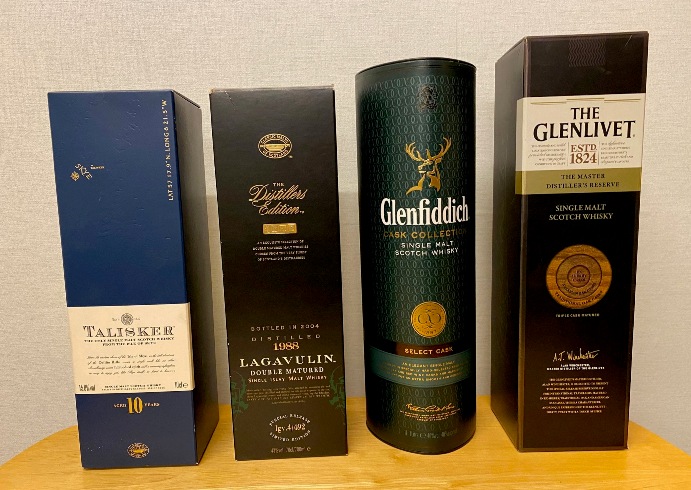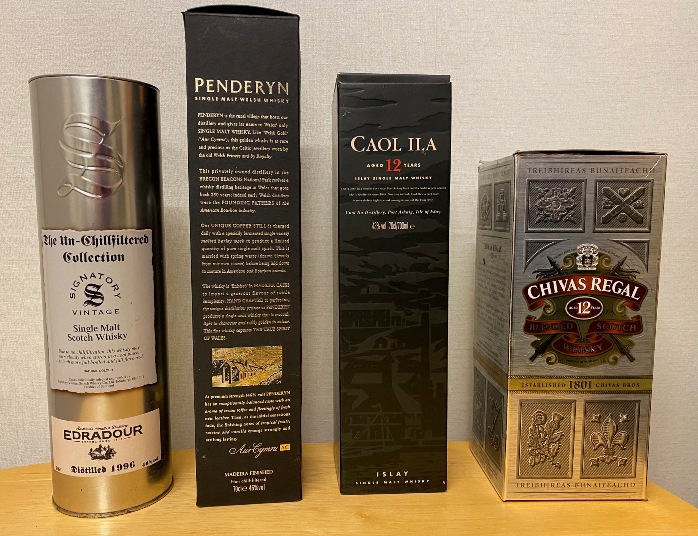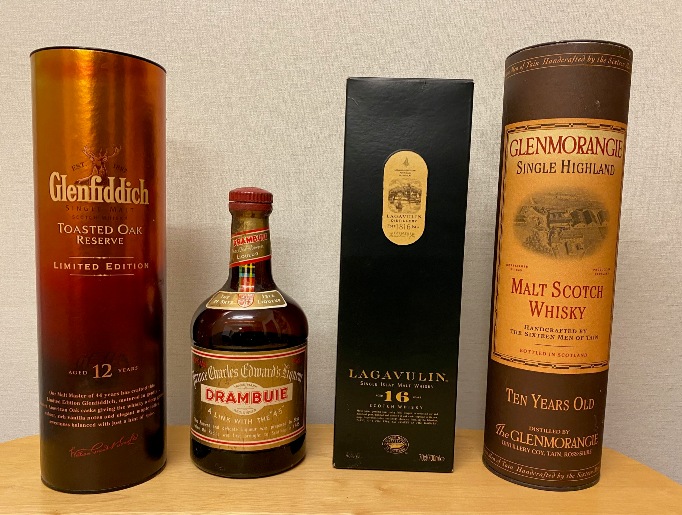| Short cuts : | Home | Contents | Photos | Ramblings | Contacts | Whats new | : : : | : : : |

I set up this page in December, 2024.
Let me start by getting the spelling right - it's whisk y for Scotch, and whisk ey for Irish, Bourbon, Jack Daniels, etc.
I didn't set out to deliberately build a Whisky Collection, but through the years I have acquired a few malt whiskies - so why not mention them here. As a Scot, I do like a good malt whisky, but mostly we are social drinkers - real ale in the pub of an evening, social drinking. I keep the whisky for special treats, medicinal purposes and special occasions - birthdays, if we have visitors, definitely New Year, etc.
We Scots have been enjoying our whisky for over 500 years. Most supermarket retail types are a blend of about 25% malt whisky, and 75 % grain whisky. Basically, the process is a clever mix of science and art requiring only three basic ingredients - water, barley (or another grain) and yeast. For a Scottish malt we start with dry barley usually grown locally, steep it in water so the the starch in the grain swells as it is convered to sugar, and then dry the swollen barley. This is usually on a big warehouse or barn floor for three to seven days, turning the grain occasionally. Sometimes the Distillery burns local peat for heat required at various stages - and these peat fumes can enhance the final flavour. Distilleries first produce a strongish beer from the malted barley - add water and sprinkle in yeast to produce a tub of "wash" of about 8% alcohol strength by volume. This is then heated to concentrate it to about 21% alcohol, and then further heated in a separate spirit still to evaporate and collect the vapours by fermentation and condensation. Distillation is an old process which was even known to the ancient Egyptians. Scottish stills are usually made of copper which eliminates sulphurous compounds that would impair the flavour. The design of the still in each Distillery is the result of probable historical trial and error, and dare not be changed for fear of losing the whisky's unique flavour and characteristics. For example, Glendiddich - only the lightest of spirits will escape out of their long necked stills, producing a distinctive, more delicate whisky. The resulting mix of spirits (typically 40% to 46% by volume) and water (60% to 54% ) is stored in wooden casks or barrels, and matured for at least 3 years for a grain whisky, or ten years plus for a malt. A little alcohol evaporates on storage and maturing - "the angels share" - so the initial alcohol content should be greater than 40% to allow for this. Various casks impart a variety of colour and flavour depending on the type of barrel - American Oak, European Oak, smoked or not smoked, etc - and also what the barrels previously contained - Madeira, Port, Wine, Sherry, etc. Flavour is also a result of the source of local water (eg a peaty flavour, hardness, softness etc.), and where the maturing whisky is stored - eg humidity, near prevailing ozone rich sea breezes, etc. Some whiskies are sold as produced (single malt whiskies) or as blends. The blend can be the same malt whisky but from different casks types (blended to get consistency of taste and flavour) or a blend of different malt whiskies, or a blend of a malt with a grain whisky for the mass market.
Whisky can be categorised by region - Speyside, Highlands, Islands, or Lowlands. Traditionally, people speak of Scotland's six classic malt whiskies :
Talisker - Islands
Glenkinchie - Lowlands
Dalwhinnie - Highland
Cragganmore - Speyside
Oban - West Highland
Laguvulin - Islay
I like the flavour chart copied above where flavour moves from Delicate to Smoky on the vertical axis, and strength from Light to Rich in the horizontal axis. For whisky tasting experiments, why not start with a whisky in the middle of the chart and compare it with one at an extreme. See which taste you prefer, and then move further up or down, or along or back to zoom in on a favourite. However taste depends on the occasion and mood. Have fun experimenting, and enjoy.
Links to whisky index and home page
| Whisky Index Heading | Go to Home Page |

I set up this section in December, 2024.
The region is Islands, and this bottle is 46% alcohol by volume. Talisker is in the top right corner of the above flavour chart - i.e. it's a powerful, smoky, rich whisky. The Distillery is at Carbot, in the Isle of Skye. It was founded in 1830 but had to be rebuilt in 1960 as the result of a terrible fire caused by ignition of escaping spirit. On rebuilding they were careful to replicate the old pot stills and worm tubs. Talisker is one of Scotland's six classic malts.
Links to whisky index and home page
| Whisky Index Heading | Go to Home Page |

I set up this section in December, 2024.
The region is Islay, i.e. Islands and this bottle is 43% alcohol by volume. This special edition whisky was produced in 1988, matured in Perdo Ximenez cask wood for 16 years, and bottled in 2004. Laguvulin is from the extreme top right of the flavour chart - about as strong and peat smoky as you you can get, you can taste the sea. The Distillery is at Port Ellen, on the Isle of Islay and was founded in 1817. The other famous Islay malt is Laguvulin's rival or higher selling cousin Laphroaig.
Links to whisky index and home page
| Whisky Index Heading | Go to Home Page |

I set up this section in December, 2024.
The region is Speyside, and the strength 40% alcohol, by volume. The Glen Grant Distillery was founded in 1887 at Dufftown, Banffshire and draws water from the nearby Robbie Dhu Springs. This cask collection whisky was martured in Bourbon European Oak casks. Glenfiddich is a top selling single malt.
Links to whisky index and home page
| Whisky Index Heading | Go to Home Page |

I set up this section in December, 2024.
The region is Speyside, and the strength 40% alcohol, by volume. The Distillery was founded in 1824 at Ballindalloch , Banffshire. This Masters Distiller's reserve edition, triple Sherry American Oak cask matured whisky has a bright gold colour and is sweet and smooth. In the flavour chart above, GlenLivet is sort of middle, light delicate bottom left positioned. There are other distilleries in the Glen, but this original one in the only one allowed to call itself The Glenlivet.
Links to whisky index and home page
| Whisky Index Heading | Go to Home Page |

I set up this section in December, 2024.
The region is Highlands, and the strength 46% alcohol, by volume. The Distillery is in Pitlochry, Perthshire and was founded in 1825. It is reputably Scotland's smallest Distillery, producing less in a year than say Glenfiddich would do in a week ! This edition was bottled in Edinburgh. It is a bottle I acquired from my son Jamie. This whisky is probably mostly used in blends, and is not well enough known to appear on the above flavour chart, but it is smoky, full flavoured.
Links to whisky index and home page
| Whisky Index Heading | Go to Home Page |

I set up this section in December, 2024.
This is a 46% alcohol by volume single malt Welsh whiskey, first matured in American Oak Bourbon casks, and then finished in Madeira ones. The original Distillery was set up in 2004 in the village of that name in what used to be called the Brecon Beacons. It uses Scottish know how, a traditional copper still, and has it's own sourced spring water. It is golden coloured, smooth and light. Two other "Penderyn" distilleries were set up in 2021 and 2023, both in Wales.
This bottle was a present from my Welsh friend Darrell Thomas. I was a bit dubious about what it would taste like, but was pleasantly surprised. It was OK, more than just quite acceptable. We have beeen using this whiskey through the years mixed into Christmas Puddings, and it was also brilliant (46% proof) for the traditional setting fire to the pudding on Christmas Day. We depress a slight hollow on top of the pudding, and pour in some Penderyn - it is easily ignited and the flames are sustained for a pleasingly long time. If you can't make out the words in the picture this may be because they are in Welsh. The English translation is on the back.
Links to whisky index and home page
| Whisky Index Heading | Go to Home Page |

I set up this section in December, 2024.
The region is Islands, or more specifically Islay, and the strength is 43% alcohol, by volume. The Distillery was founded in 1846, at Port Askaig, on the Isle of Islay. It draws water from the nearby loch - Loch nam Ban. In the above flavour chart it is in the top left quadrant - a smoky, peaty whisky with a touch of lightness. As an Islay whisky you can taste the sea. I think it's a good starting point for tasting an Islay malt. A school classmate was initially brought up in Islay, and this is his favourite Islay malt.
Links to whisky index and home page
| Whisky Index Heading | Go to Home Page |

I set up this section in December, 2024.
This is a blend of mostly Speyside malt whiskies including from the Keith based Strathisla Distillery, set up back in 1786, the oldest operating Distillery in the Highlands. The blend was first developed by the Chivas Brothers in Aberdeen over a century ago. This particular sample is 43 % alcohol by volume, and 12 years aged. This blend is my recommended whisky to try if if you are new to whisky drinking.
Links to whisky index and home page
| Whisky Index Heading | Go to Home Page |

I set up this section in December, 2024.
I have two bottles of Glenfiddich, one standard and one a special cask collection example. As before the region is Speyside, and the strength 40% alcohol, by volume. It's 12 years matured. The Glen Grant Distillery was founded in 1887 at Dufftown, Banffshire and draws water from the nearby Robbie Dhu Springs. Standard Glenfiddich is a blend from three types of casks - Bourbon, European Oak, and red wine - which gives consistency of taste. The cask collection whisky homes in on one type of cask - a clever way of marketing something "premium" at a slightly higher price ? Glenfiddich is of course, a top selling single malt. Glenfiddich is in the bottom left quadrant of the flavour chart - light and delicate.
Links to whisky index and home page
| Whisky Index Heading | Go to Home Page |

I set up this section in December, 2024.
This is the oldest British whisky liqueur - it's 40% alcohol by volume and from the Isle of Skye. There is a nice story from 1745 about Bonnie Prince Charlie escaping to Skye and being sheltered by the local chieftain Mackinnon of Skye. This exclusive royal liqueur had been created by the Prince's apothecary, and Prince Charlie gave the recipe in gratitude to Mackinnon. It's a secret mix of Scottish malt whisky, heather honey, herbs and spices, guarded and handed down through the centuries. Apparently now, only three people know the exact recipe, and one of the three mixes the special blend of herbs that goes into every production. It's a wonderful slightly viscous concoction. Sip it, allow the liqueur to lie under the tongue, and let it diffuse slowly into the blood stream. It's for savouring ! This is the ultimate medicine, especially for colds and flu's. We also have and like Benedictine liqueur.
Links to whisky index and home page
| Whisky Index Heading | Go to Home Page |

I set up this section in December, 2024.
As per Glenfiddich, I have two bottles of Laguvulin, standard and spcial. As before, the region is Islay, i.e. Islands and this bottle is 43% alcohol by volume. Standard blends a mix of maturings for consistency, and this special edition whisky was produced in 1988, matured specifically in Perdo Ximenez (i.e. wine / sherry) cask wood for 16 years, and bottled in 2004. Laguvulin is from the extreme top right of the flavour chart - about as strong and peat smoky as you can get, you can taste the sea. The Distillery is at Port Ellen, on the Isle of Islay and was founded in 1817. The other famous Islay malt is Laguvulin's rival or higher selling cousin Laphroaig. Caol Ila is also from Islay, but is more specialised.
Links to whisky index and home page
| Whisky Index Heading | Go to Home Page |

I set up this section in December, 2024.
The region is Highlands, the strength 43% alcohol, by volume, and it's 10 years matured. The Distillery Coy is in Tain, Ross-shire, and was set up in 1843. It uses locally grown barley, and water from it's nearby Garlogie Springs. It's matured in American oak barrels in warehouses by the sea. When we had a tour of the Distillery a few years ago we were told you can taste which whisky was matured in the warehouse nearest the sea - a nice story, but of course my palate is not that refined. In that same tour I was persuaded to add a drop of local water to my taster dram. Maybe I overdid the water volume, but I thought it ruined a good dram, and I have never repeated that mistake. Glen Morangie is Scotland's top selling malt whisky, and nearly all the production, i.e. 95%, is sold as a single malt, and only 5 % used in blends. In the flavour chart it's half way between light and rich, and towards the delicate range. I think I would recommend this is a second starter whisky, after perhaps the Chivas Regal blend. Glen Morangie is readily available - Morangie rhymes with the fruit "orange".
Links to whisky index and home page
| Whisky Index Heading | Go to Home Page |